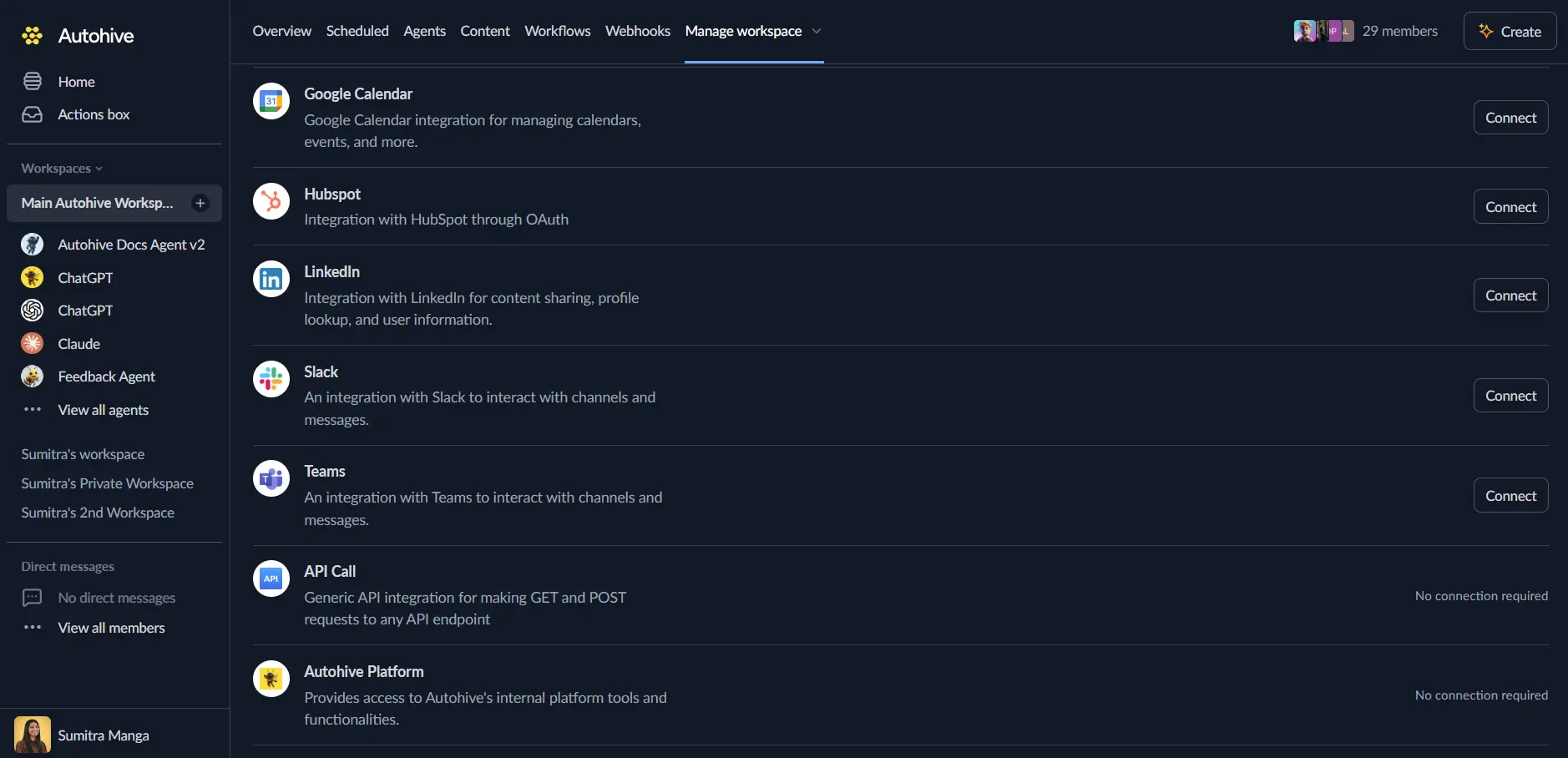Google Drive
The Autohive Google Drive integration connects your Google Drive with Autohive’s automation platform, enabling:
- File management - Upload, download, rename, and organize files across personal and shared drives
- Folder operations - Create folders, list contents, and manage hierarchical file structures
- File search and discovery - Search files using Google Drive’s powerful query syntax with filtering and sorting
- Shared drive access - Manage files in team shared drives with full collaboration support
- File organization - Star important files, move files between folders, and maintain organized storage
- Metadata handling - Access comprehensive file information including creation dates, sizes, and MIME types
- Binary file support - Handle all file types including documents, images, videos, and binary data
- Pagination support - Efficiently navigate large file collections with built-in pagination
Install the integration
-
Log in to Autohive and navigate to Your user profile > Connections or Your workspace -> Manage workspace
-
Locate the Google Drive Integration card and click Connect

-
Select your Google account and click Choose Account
-
Review and approve permissions. Autohive requests access to:
Ensure you approve the permissions required in order for the integration to function as expected.
-
Confirm installation - you’ll be redirected to Autohive with “Connected” status displayed
Use the integration
You can now use the integration with your agents, workflows and scheduled tasks!
- Follow our Create your first agent guide on how to create an agent.
- In the ‘Agent settings’, scroll down to the ‘Add capabilities’ section and turn on the Google Drive capability. You can choose what individual Google Drive capabilities to turn on and off.
- Once the settings have been selected, begin prompting the agent of the workflow you’d like to achieve with Autohive and Google Drive!
Available capabilities
File Management
- Get File: Download and access file content with complete metadata including creation dates and sizes
- Write File to Drive: Upload new files to personal or shared drives with base64 content encoding
- Rename File: Change file or folder names while maintaining their current location and structure
- Move File: Transfer files and folders between different locations within the same or different drives
Folder Operations
- Create Folder: Generate new folders in personal or shared drives with optional descriptions
- List Folder Contents: View all files and subfolders within specific directories with pagination support
- Folder Hierarchy Management: Navigate and organize complex folder structures efficiently
File Discovery and Search
- List Files: Browse all files with advanced filtering using Google Drive’s query syntax
- Advanced Search: Filter files by name, type, modification date, owner, and custom criteria
- Sorting Options: Order results by name, modification time, size, or other metadata fields
- Pagination Support: Handle large file collections efficiently with token-based pagination
Shared Drive Management
- List Shared Drives: Access all team drives available to your account with full metadata
- Shared Drive File Operations: Work with files in collaborative team environments
- Cross-Drive File Movement: Transfer files between personal and shared drives seamlessly
File Organization
- Star File: Mark important files for quick access in the starred section
- List Starred Files: Retrieve all starred files across personal and shared drives
- File Status Management: Control file visibility and organization preferences
Metadata and Information
- Comprehensive File Data: Access creation times, modification dates, file sizes, and MIME types
- Parent Folder Tracking: Maintain awareness of file location and hierarchy
- Binary File Support: Handle all file formats including documents, images, and media files
Key features
Advanced Search Capabilities
- Use Google Drive’s powerful search syntax for precise file discovery
- Search by file name, content, type, owner, and sharing status
- Combine multiple search criteria with boolean operators
- Filter by date ranges and file properties
Shared Drive Collaboration
- Access team shared drives with appropriate permissions
- Upload and organize files in collaborative environments
- Maintain file sharing settings and access controls
- Support for enterprise and team Google Workspace accounts
Binary File Handling
- Upload and download files of any type and size
- Base64 encoding support for binary data transmission
- Preserve file integrity for media, documents, and executable files
- Handle large files efficiently with streaming support
Efficient Pagination
- Navigate large file collections without performance impact
- Token-based pagination for consistent results
- Configurable page sizes for optimal loading times
- Forward and backward navigation through file lists
Supported file types
The integration supports all Google Drive file types including:
- Documents: Google Docs, Microsoft Office files, PDFs, text files
- Spreadsheets: Google Sheets, Excel files, CSV data
- Presentations: Google Slides, PowerPoint files
- Media Files: Images (JPG, PNG, GIF), videos (MP4, AVI), audio files
- Archives: ZIP files, compressed folders
- Code Files: Source code, scripts, development files
- Binary Files: Applications, executables, and specialized formats
Disconnect the integration
Important: Disconnecting stops data synchronization but preserves existing data in both systems.
- Navigate to Your user profile -> Connections or Your workspace -> Manage workspace
- Find the Google Drive Integration
- Click Disconnect and confirm
Data Impact: Existing data remains unchanged in both systems, but sync stops and Autohive loses Google Drive API access.
Uninstall the app
From Google: Go to your Google Account settings > Security > Third-party apps with account access > Find Autohive and revoke access